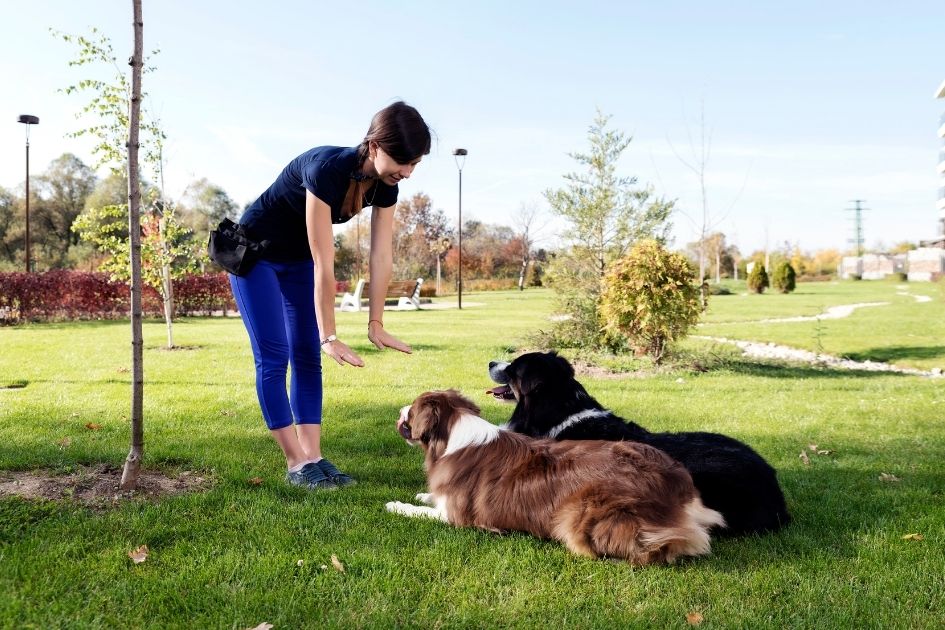Dog board and training programs do seem like a good solution as it takes the pressure off you, but is it worth it?
The time commitment needed to train a dog is not one everyone has.
Life throws a lot of responsibilities at us, and we find ourselves neglecting the training of our pet pooch, much to its detriment.
So, some opt to send off their pet to a board and train dog training facility, which is like a boarding school for dogs.
We’ll answer the questions that you might have by examining the pros and cons of dog board and training.
What is Board and Train?
Like we hinted above, a board and train institute is similar to a boarding school or summer camp.
Other names for this program are dog boot camp, dog training boarding school, and dog training camp.
Simply put, it involves delegating the training responsibilities of your dog to an establishment of professionals.
The canine remains there for a stipulated time to get the training it needs.
These programs often take your pooch through basic training, socialization with other dogs, and some fun time.
Your pup also gets some individual training with a professional trainer.
Feeding is often up to you, and you’d be required to give some information that would help the staff take care of your pet.
Types of Dog Board and Training Programs
Generally, board and training programs are categorized into two broad types. They are:
1. In-home board and training program

In this type of training, your pet lives with the trainer and is trained in a household environment.
During that period, it is taught good manners, given some activities to do, and is trained to live indoors. It also gets to socialize with other dogs.
Training duration may be a minimum of 1 or 2 weeks, depending on what is required. The response of your pup also influences duration.
2. Kennel Board and Train
Here, the dogs stay outdoors in a kennel, rather than a living room space.
Training is done outside, after which the dogs return to their kennel. This could be better for energetic dogs who can’t cope indoors.
Training may also last for up to 2 weeks or lesser. Like the In-home board and training program, the timing may depend on your dog.
What Happens at a Board and Train Dog Training?
Board and train facilities offer courses that deal with different aspects of dog training. They include:
1. Basic training
In this course, dogs are taught basic commands to learn and obey. Some of these commands are common ones like Sit, Heel, Come, Stay.
Dogs may also be taught not to do something, such as jumping on people or bolting out of an open door.
2. Changing habits
The dogs are taught to drop a habit or bad behavior in place of a better one.
This is often called dog behavior modification and is done on canines who may have developed some issues like aggression and anxiety.
It is a slow but productive service, using different methods to get the dog to change its behavior.
There are some requirements many board and training facilities will ask for. Some of them are:
- Vaccination records
- Food
- Leash, collar, and tags
- Medications
- Contracts and agreements to sign
Board and Train Pros and Cons

Now that we have a basic idea of what this is about, here are the advantages and disadvantages of this program.
Benefits
1. Your pooch gets trained
The main purpose of this program is to give dogs adequate training.
A lot of these facilities are equipped with experts who take your pet through different training processes you may not have known about.
The experience of the trainer makes it more probable that the dog will be well trained.
They also have many techniques that can be tried out to ensure your pet co-operates.
At the end of the day, you should be getting a better trained pet for you to continue the pet journey with.
2. They provide a safe space for pups
If you want to go on a vacation or have some other activity that will take up most of your time, you can keep your dog safe at a board and training program.
It is far better than leaving your furry friend with your neighbor who doesn’t have the experience of professional trainers.
With these programs, you get to give your dog extra training while you take care of pressing duties or get a tan in Hawaii. It’s a win-win.
3. It reduces the risk of boredom
Let’s face it, being in the same environment can get anyone bored, dogs inclusive.
If training sessions feel repetitious and your pet shows signs of wanting more stimulation, a board and training program will help.
Here, your dog will be in a new environment, meet other canines, and should be more willing to work with the trainer.
4. It can take care of some bothersome behavior
While these programs are not elixirs for all behavioral issues you may face with your pet, they do help resolve some.
This helps ease the frustration you may face trying to correct these behaviors.
These programs can also teach good habits you may not have considered for your pooch.
Disadvantages
1. Not all trainers have good ethics
Reassurances and contracts notwithstanding, you may never know what methods the trainers use for training.
Some resort to punishments, shock collars, and other unhealthy techniques that will do more harm than good.
There are the lazy and underqualified ones too. They slack on their responsibilities, not giving the dogs adequate training.
Do your research before entrusting your pet to any trainer or facility. Look out for reviews from past clients and references before making any final decisions.
2. Training is not perfect
Even the best facilities will not do your job for you. While the weeks of training go a long way, you should maintain it by continuing where the trainers stopped.
Without practice, your pup may get back to where you started.
A good trainer will keep you updated on the techniques and methods used while training so you can implement them.
3. It doesn’t solve all problems
Board and training programs do work on behavioral issues, but not every habit can be resolved by them.
Also, not every dog breed should be sent away to a facility.
Velcro dogs who are prone to separation anxiety are good examples of pets that shouldn’t be left with foreign trainers.
Separation anxiety is best resolved in a familiar environment.
4. It cuts bonding moments
The fun of training is the bond that forms between you and your pooch as you teach, play, praise, gently rebuke and repeat the process.
You miss out on this when you shift the responsibility to someone else.
It is recommended that you start the training process of your pet before considering taking it for a board and training program.
Is Dog Board and Train Worth it?
There are many advantages of board and train dog training and it can be a temporary solution to a problem.
Just remember that there is no magic in these programs that can make your dog a perfect pooch in a few weeks.
While looking for a decent facility, avoid those who use phrases like:
- Dominance and submission
- Making you the alpha
- Controlling
- Punishments
Instead, go for those who tell you about methods that are:
- Force-free
- Based on actual evidence
- Based on science
- Fear-free and humane
- Positive and rewarding
Be inquisitive too. Ask many questions to know about certifications, the code of ethics of the facility (if there isn’t, that’s suspicious), recommendations, the living environments, emergency first aid, and the location.
Only when you’re satisfied should you go ahead.
FAQs
Is it OK to send your dog away for training?
In some situations, putting your dogs in the hands of professionals is advisable. They can help teach good manners and correct some issues.
However, bear in mind the disadvantages of this act, and do not think the professionals will do all the work for you.
Is board and train good for separation anxiety?
Board and Train are helpful for many issues, but it may be stressful for a dog who’s vulnerable to separation anxiety.
These dogs should be in a familiar environment, not away from those they love.
How much is dog boarding and training?
You should take into account the price of training while considering this option. It isn’t cheap and may require a budget.
Generally, trainers charge from as low as $1,000 up to $2,500 for some weeks of training.
Is it bad to board and train a puppy?
Board and training can be beneficial to a puppy, but it has its weaknesses.
During the first few months, a pup should bond with its owner. This can’t happen if it is sent away.
Thus, while its board and train aren’t bad for a puppy, it should have the right time.
The Bottom Line: Should I Board and Train my Dog?
With all you know, it should be easier to decide whether a dog board and training program is best for your pup or not.
With its share of advantages and disadvantages, it isn’t for every pet parent. You should know the needs for your dog and if they can be solved by this program.
Remember that training is a pet parent’s responsibility, not the trainer’s.
Be involved in your dog’s growth, even if you keep it at a board and train facility.
You May Also Like:
6 Crate Training Pros and Cons: Will Your Pup Hate You?







